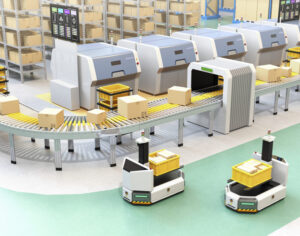Retailers in Philadelphia and around the Northeast are driving traffic and sales by deftly combining the best of both worlds—online and “IRL” (in real life).
Don’t be intimidated by all of the jargon—”multi-channel,” “omnichannel,” “BOPIS” and everything in between. At Equity Retail Brokers, we agree with the view expressed by Steve Dennis, a retail consultant and Forbes contributor, who wrote:
Simply stated, a great customer experience has never been about being everywhere and being all things for all people. What matters is showing up for the right customers, where it really matters, in remarkable ways.
That’s an important distinction. It means that even independent, local retailers can have a meaningful online presence, and that even some larger chains may not have to spend billions of dollars (along the lines of Target and Walmart) to drive traffic and sales to their stores and websites.
E-Commerce and Commercial Real Estate in Philadelphia and the Northeast

Rumble Boxing is a great example of an operator with a comparatively simple—but effective—strategy for leveraging the power of online commerce. With a location in Philadelphia and multiple gyms in New York, Rumble bills its workouts as a “10-round, 45-minute fight”—a communal, intensely physical experience packed with the “skills and drills of boxing” and the “transformative power of resistance training.”
You may wonder how the Internet could ever factor into a boxing workout. In fact, for many Rumble devotees, it all starts online on Monday morning at 7. That’s when two full weeks of classes open up for booking. You pick up your phone, tablet or laptop, schedule your workouts and you’re ready to…well, Rumble. The convenience and ease of this approach gets the job done nicely.
But of course, when retail inventory is part of the picture, the strategic imperatives get more complex. For many of today’s retailers, a top priority is making it easy and simple for customers to order things online and pick them up at the store, whether curbside, at a pickup area or from a kiosk (see Walmart’s high-tech Pickup Towers). The buzzwords here include BOPIS “buy online, pickup in store” and click-and-collect.
With locations all over the Northeast, Pet Supplies Plus gives its online customers the ability to add products to their “carts” and schedule a pickup at their local stores, usually within two hours. You simply call when you get there and an associate brings the items to your car.
Unifying the Brick-and-Mortar and E-Commerce Experience
Another top priority today is for shoppers to be able to search for products on any channel in which a retailer operates and find out whether specific items are in stock.
Let’s say you’re at lunch. You go to your favorite retailer’s website on your phone, find a sweater you love, but then get distracted and forget to order it. If you go back to find it later on another channel offered by that chain—for example, its mobile app—you’ll be annoyed if you can’t find it there, too. You want to be able to pick up right where you left off.
More retailers are focused on cross-channel searchability. They also know that if you load your cart with five items on the website, your cart should automatically update in the app and any other channels in which you’re logged in as well. Ditto for your loyalty points and returns. Meanwhile, back at the store, it’s imperative that the inventory actually matches how it is represented online: You never want a shopper to log onto a channel, reserve something, drive to the store and find that it is, in fact, out of stock.
That still happens today, especially in grocery, where a “picker” may discover too late that your particular brand of frozen french-fries needs to be substituted. However, we are rapidly moving to a world in which such gaps are a thing of the past.
Savvy Approaches to Omnichannel Retail
Bloomingdale’s is among the standouts when it comes to driving traffic and sales by combining smart Internet strategies and physical stores. The department store chain operates Pennsylvania locations at The Court at King of Prussia, Willow Grove Park Mall and Liberty Place Outlet. Let’s say you’re at Willow Grove and you find some pants, but in the wrong size. The Bloomingdale’s app lets you scan those pants, find the right fit, and have them sent right to your house.
Operators like Chipotle Mexican Grill and Starbucks also continue to leverage online-ordering strategies to make it easier than ever to spend money at their locations. You call up the app, order your favorites and pick them up, often without leaving your car. (Chipotle increasingly takes the kinds of pad and end-cap sites that make Starbucks-like drive-throughs possible.) And of course, deals with the likes of DoorDash and Uber Eats continue to drive online sales to all manner of food-and-beverage operators.

But we’re also seeing some futuristic evolution when it comes to rapid, last-mile fulfillment of online orders by traditional retailers. Last year, Wakefern Food Corp., the parent company of ShopRite, partnered with startup Takeoff Technologies to open a so-called micro-fulfillment center (MFC) in Clifton, New Jersey. Think robots instead of human pickers. The goal is to fulfill online orders much faster than the manual approach of walking the aisles and pulling different items. According to Chain Store Age, Takeoff Technologies’ MFCs can assemble an order of up to 60 items in just a few minutes. The initial target markets: New Jersey and New York.
Meanwhile, Giant Food Stores, as part of its plans to invest $114 million in Pennsylvania over an 18-month period, announced that it would build a new Giant Direct e-commerce fulfillment center and pickup facility in Philadelphia, its second such fulfillment center in the state.
Lastly, Kroger announced its own plans to partner with fulfillment specialist Ocado on a center in Frederick, Maryland. The Cincinnati-based supermarket chain aims to bring its e-commerce solution to Washington D.C., Baltimore and Philadelphia as part of its expansion plans for the region.
It’s important to note that smaller retailers could certainly partner with startups like Takeoff Technologies or Israel-based Fabric, another creator of MFCs. Let’s say you’re a local operator with three or four stores in a market, and you want to give your shoppers same-day delivery of online orders. Through such a partnership, you could gain access to a small, robot-equipped MFC that is located right near the neighborhoods you want to serve. Your customers order the goods. The MFC ships them out.
Everything from DoorDash to fulfillment-focused startups like Fabric may well experience much greater success going forward. As the coronavirus spurs a larger proportion of consumers to make use of delivery services, there is a possibility that this could cause a lasting shift in behaviors. Prior to the crisis, these services were already growing.
How Physical Retail and E-Commerce Can Work Together
Ecommerce now accounts for 16 percent of total retail sales, even when you factor out the sale of items not normally purchased online, such as fuel and cars, according to a Digital Commerce 360 analysis of U.S. government data.
And yet, as opposed to predictions a decade ago, the Internet has not hurt brick-and-mortar retail nearly as much as was predicted. An underappreciated culprit in the struggles of specialty retailers and department stores, in the view of some economists, is the arrival of massively popular warehouse clubs like Costco, and the continued expansion of discount retail in general—everything from dollar stores, Ollie’s Bargain Outlet and Big Lots, to higher-tier operators like Target, Walmart and the TJX Cos. concepts.
And of course, brick-and-mortar chains are racking up more and more sales via their online channels: According to TechCrunch, citing research from eMarketer, Target’s ecommerce business is set to grow 24 percent in 2020 to reach $8.34 billion. The list of retailers with fast-growing online sales includes Apple, Home Depot, Best Buy, Costco and Macy’s.
What we’re seeing today is that digital and in-person sales and interactions can and do work hand in hand. The growth of so-called clicks-to-bricks concepts like Bonobos, Warby Parker, Baublebar, SmileDirectClub, Casper and Sugarfina further proves the concept. Having launched online, they sought to beef up their offering by heading in a “new” direction: physical stores.
